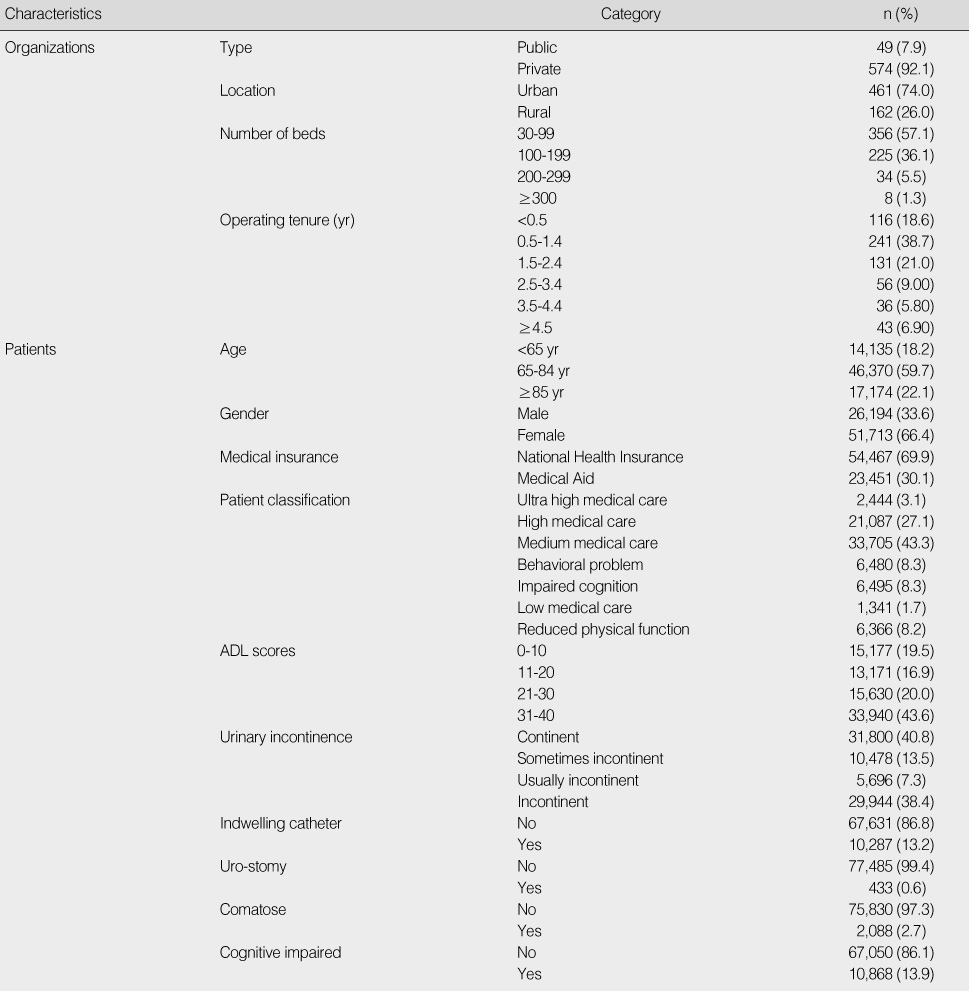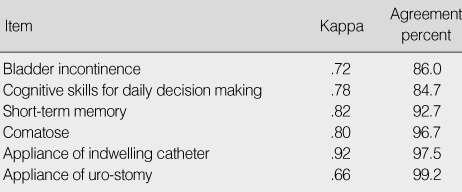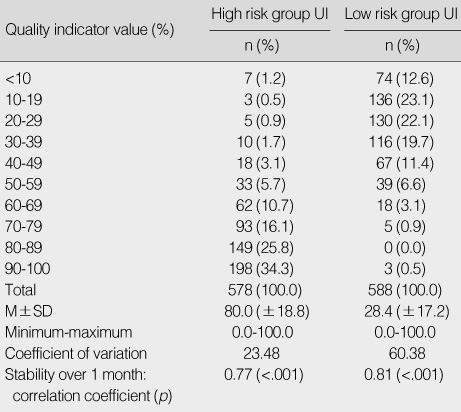Articles
- Page Path
- HOME > J Korean Acad Nurs > Volume 40(1); 2010 > Article
-
Original Article
- Development of Outcome Indicators of Urinary Incontinence for Quality Evaluation in Long Term Care Hospitals
- Ju Young Yoon, Ji Yun Lee
-
Journal of Korean Academy of Nursing 2010;40(1):110-118.
DOI: https://doi.org/10.4040/jkan.2010.40.1.110
Published online: February 28, 2010
1Doctoral Student, School of Nursing, University of Wisconsin-Madison, Madison, WI, USA.
2Full-time Lecturer, Department of Nursing, Hoseo University, Asan, Korea.
- Address reprint requests to: Lee, Ji Yun. Department of Nursing, Hoseo University, 165 Sechul-ri, Baebang-myeon, Asan 336-795, Korea. Tel: 82-41-540-9534, Fax: 82-41-540-9558, leejiyun@hoseo.edu
Copyright © 2010 Korean Society of Nursing Science
Abstract
-
Purpose
- To develop outcome indicators of urinary incontinence to measure quality of care in long term care hospitals in Korea.
-
Methods
- The draft indicators of urinary incontinence were developed from a literature review and clinical expert panel. A survey of medical records of 280 patients in 20 hospitals was conducted to test inter-rater reliability. Statistical analysis was done to test risk adjustment criteria, variation between hospitals, and stability of indicators, using assessment data from 77,918 patients in 623 hospitals.
-
Results
- The inter-rater reliability of items was high (Kappa range: 0.66-0.92). Severe cognitive impairment (odds ratio [OR]: 3.15, confidence interval [CI]: 3.03-3.26) and total mobility activities of daily living (ADLs) dependency (OR: 4.85, CI: 4.72-4.98) increased the prevalence of urinary incontinence, thus they proved to be significant criteria to stratify high and low risk groups. The prevalence for low risk showed more substantial variation than the high risk group. The indicators were stable over one month.
-
Conclusion
- This study demonstrated the feasibility of outcome indicators of urinary incontinence. Improving the reliability of the patient assessment tool and refining the indicators through validation study is a must for future study.
- 1. Arling G, Karon SL, Sainfort F, Zimmerman DR, Ross R. Risk adjustment of nursing home quality indicators. The Gerontologist. 1997;37:757–766.ArticlePubMed
- 2. Arling G, Lewis T, Kane RL, Muller C, Flood S. Improving quality assessment through multi-level modeling: The care of nursing home compare. Health Services Research. 2007;42:1177–1199.ArticlePubMedPMC
- 3. Chung J. Development and application of nursing service quality indicators in nursing homes. Journal of Korean Academy of Nursing. 2007;37:401–413.ArticlePubMedPDF
- 4. Karon SL, Sainfort F, Zimmerman D.R. Stability of nursing home quality indicators over time. Medical Care. 1999;37:570–579.ArticlePubMed
- 5. Lee JY, Yoon JY, Jang SR. A study of validity and reliability of a patient assessment instrument for long-term care hospitals. Journal of Korean Gerontological Nursing. 2008;10:7–19.
- 6. Lee JY, Yoon JY, Kim AR, Kim CM. Development of quality management system and indicators of long term care hospitals. 2008;Seoul, Health Insurance Review and Assessment Service.
- 7. Lee SH. Multi-level analysis of factors related to quality of services in long-term care hospitals. Journal of Korean Academy of Nursing. 2009;39:409–421.ArticlePubMed
- 8. Mainz J. Defining and classifying clinical indicators for quality improvement. International Journal for Quality in Health Care. 2003;15:523–530.ArticlePubMed
- 9. Ministry of Government Legislation. Medical law of Korea. 2009;Retrieved January 13, 2009. http://www.law.go.kr.
- 10. Mor V, Berg K, Angelelli J, Gifford D, Morris J, Moore T. The quality of quality measurement in US nursing homes. The Gerontologist. 2003;43(Special No.2):37–46.
- 11. Morris JN, Moore T, Jones T, Mor V, Angelelli J, Berg K. Validation of long-term care and post-acute care quality indicators. 2003;Baltimore, MD, U. S. Department of Health and Human Services Center for Medicare and Medicaid.
- 12. Mukamel DB. Risk-adjusted outcome measure and quality of care in nursing home. Medical Care. 1997;35:367–395.ArticlePubMed
- 13. Mukamel DB, Glance LG, Li Y, Weimer DL, Spector WD, Zinn JS, et al. Does risk adjustment of the CMS quality measures for nursing home matter? Medical Care. 2008;46:532–541.PubMedPMC
- 14. Mukamel DB, Watson NM, Meng H, Spector WD. Development of a risk-adjusted urinary incontinence outcome measure of quality for nursing homes. Medical Care. 2003;41:467–478.ArticlePubMed
- 15. Ouslander JG, Schnelle JF. Incontinence in the nursing home. Annals of Internal Medicine. 1995;122:438–449.ArticlePubMed
- 16. Rubin HR, Pronovost P, Diette GB. The advantages and disadvantages of process-based measure of health care quality. International Journal for Quality in Health Care. 2001;13:469–474.PubMed
- 17. Schnelle JF. Managing urinary incontinence in the elderly. 1991;New York, NY, Springer Publishing Company.
- 18. Zimmerman DR, Karon SL, Arling G, Clark BR, Collins T, Ross R. Development and testing of nursing home quality indicators. Health Care Financing Review. 1995;16:107–127.PubMedPMC
REFERENCES
Figure & Data
REFERENCES
Citations

- Development of Health Assessment Tool for Middle-aged Adults in Long-term Care Settings
Yoon-Jin Park, Nam Cho Kim
The Korean Journal of Rehabilitation Nursing.2017; 20(1): 1. CrossRef - Factors Associated with the Changes in Activities of Daily Living in Older Adults with Stroke: A Comparison of Home Care and Institutional Care
Woon-Sook Jung, Eun-Shil Yim
Journal of Korean Academy of Community Health Nursing.2016; 27(4): 388. CrossRef - Mobility is the key! Trends and associations of common care problems in German long-term care facilities from 2008 to 2012
Nils A. Lahmann, Antje Tannen, Simone Kuntz, Kathrin Raeder, Gabriela Schmitz, Theo Dassen, Jan Kottner
International Journal of Nursing Studies.2015; 52(1): 167. CrossRef - Comparison of Hospital Standardized Mortality Ratio Using National Hospital Discharge Injury Data
Jong-Ho Park, Yoo-Mi Kim, Sung-Soo Kim, Won-Joong Kim, Sung-Hong Kang
Journal of the Korea Academia-Industrial cooperation Society.2012; 13(4): 1739. CrossRef - The impact of organizational factors on the urinary incontinence care quality in long-term care hospitals: A longitudinal correlational study
Ju Young Yoon, Ji Yun Lee, Barbara J. Bowers, David R. Zimmerman
International Journal of Nursing Studies.2012; 49(12): 1544. CrossRef
General characteristics of Organizations and Patients (N=77,918)
ADL=activities of daily living.
Draft of Quality Outcome Indicator of Urinary Incontinence
ADL=activities of daily living.
Inter-rater reliability of item for Outcome Indicators of Urinary Incontinence
Test of Risk Adjustment factors
ADL=activities of daily living; CI=confidence interval.
Variance of Quality Indicator value among hospitals and Stability over time
UI=urinary incontinence
ADL=activities of daily living.
ADL=activities of daily living.
ADL=activities of daily living; CI=confidence interval.
UI=urinary incontinence
 KSNS
KSNS
 E-SUBMISSION
E-SUBMISSION





 Cite
Cite

